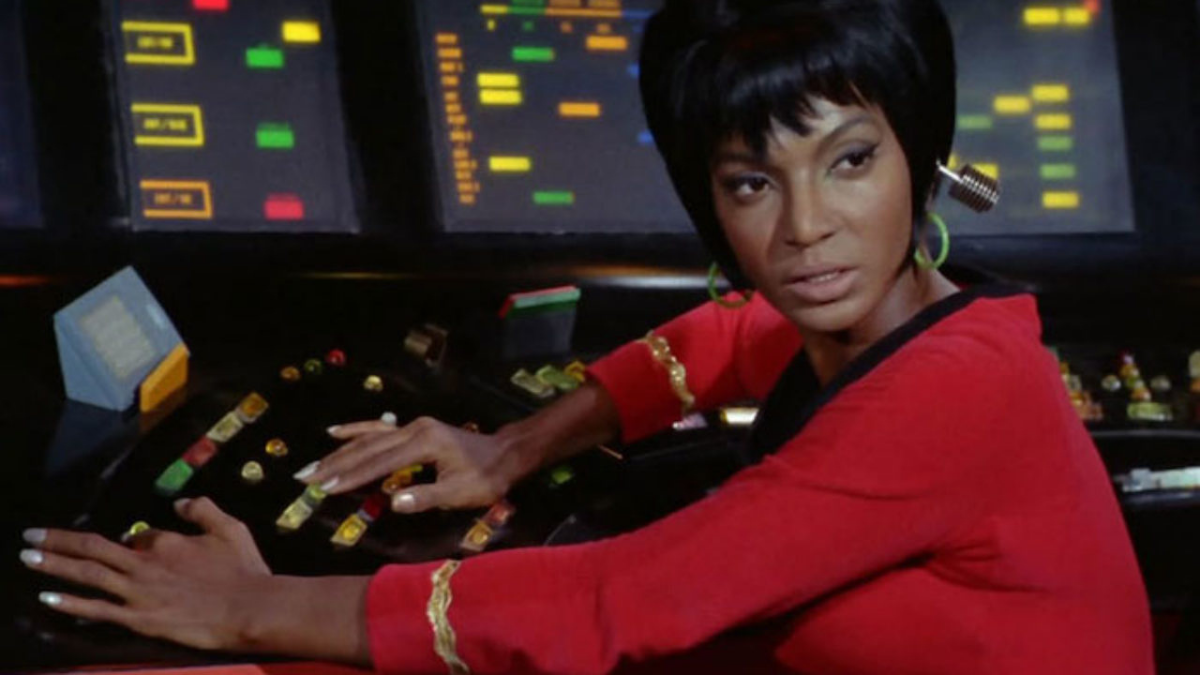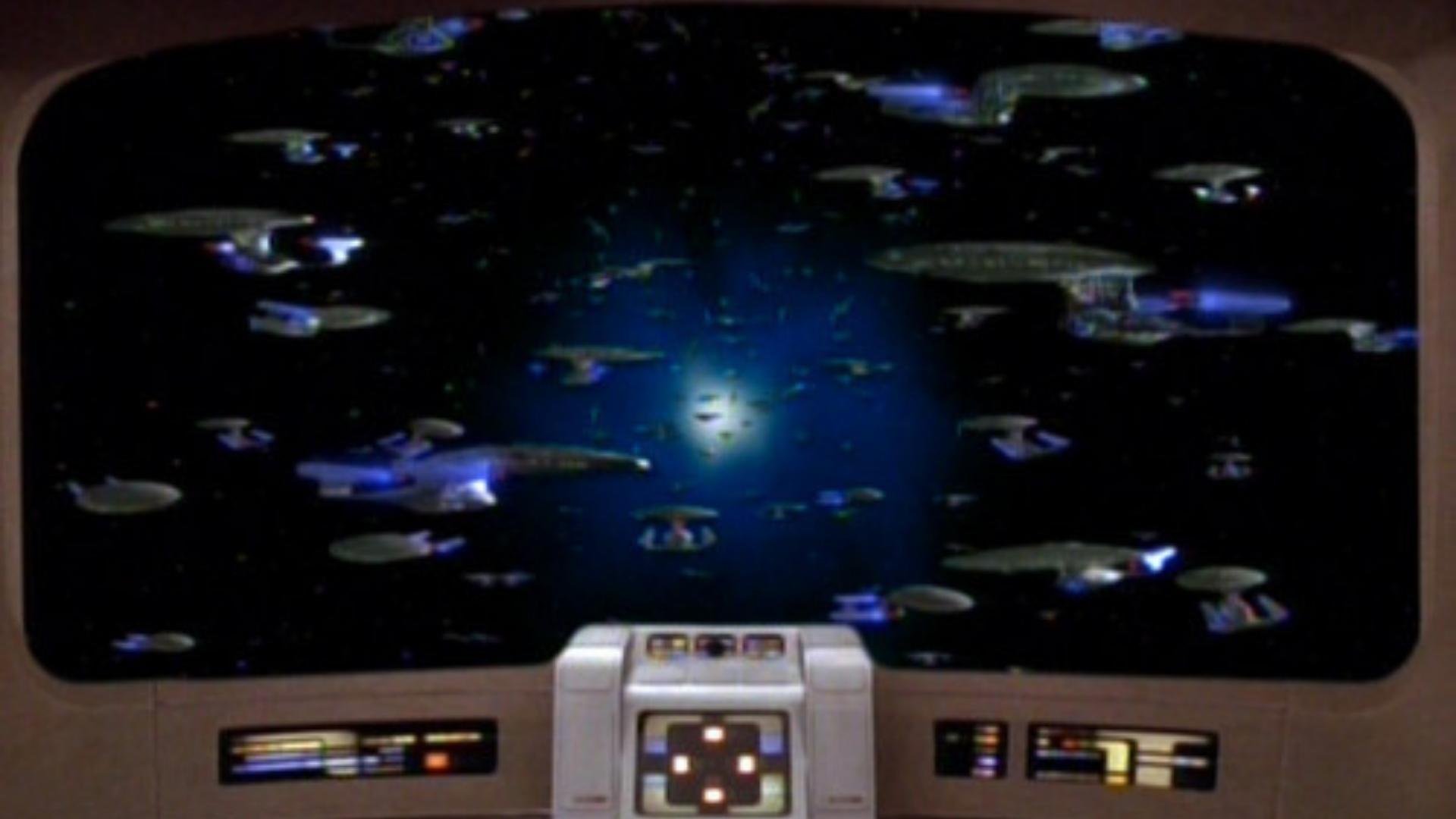T's Trek Trivia Tuesday: "Hailing Frequencies Open"

Nichelle Nichols as Lieutenant Uhura in STAR TREK
Unless you’ve been on Alpha Centuri for the past couple of weeks, you’ve undoubtedly heard the news that iconic actress Nichelle Nichols has passed away. Nichols played Lieutenant Uhura, a much-loved and, in many people’s opinion, underused Star Trek character. We’ve been reflecting on the life and legacy of Nichols this past week and thought it was a good time to see how much you know about our favorite communications officer.
Most Trek fans know the story of how at the end of the first season, Nichols resigned from the series, much to Gene Roddenberry’s chagrin. It was at an NAACP fundraiser that she met her #1 fan, Martin Luther King Jr., and he talked her out of quitting. It’s fascinating to think about how the very first line the audience ever heard her utter anticipates her reason for exiting the show.
What were the first lines America got to hear from her?
Yeoman Rand (Grace Lee Whitney) and Lieutenant Uhura (Nichelle Nichols) talk about their encounters with the "salt vampire" in STAR TREK's "The Man Trap"
In the first episode of Trek ever aired, in the first scene on the bridge of the Enterprise ever viewed, Uhura makes her way from her communications station at the back of the bridge to the command chair, currently occupied by Spock.
“Miss Uhura, your last sub-space log contained an error in the frequencies column,” Spock tells her.
“Mister Spock, sometimes I think if I hear that word ‘frequency’ once more, I'll cry,” Uhura tells him.
This exchange of dialogue is the first that soon-to-be Star Trek fans ever heard from either character. By the end of the first season, Nichols felt the same way her character did about the “f” word. She had been promised a meaty part, but pieces of dialogue and important moments that had been written for her were routinely cut, leaving her to repeat the line “Hailing frequencies open, sir” over and over again. She realized her mistake when King pointed out that as a black woman who wasn’t simply playing a waiter or servant but rather, had an important job on a starship, she was showing other African-Americans that they had a place in the future.
Nichols was originally a singer and dancer, and Trek took advantage of her talents. In Star Trek V: The Final Frontier, Uhura, sillouhetted against the moon, performed an alluring song and dance that drew a group of enemies into an ambush. That wasn’t the first time the communications officer used song communicate. She was heard humming and serenading people throughout the Original Series.
When was the first time she showed off her talent on Star Trek?
In the episode “Charlie X,” the Enterprise’s young guest, Charlie Evans, walked into the officer’s lounge to find Uhura singing “Oh, On the Starship Enterprise,” accompanied by Spock on the Vulcan lyre. The song is fun and flirty, and Uhura improvises the lyrics to tease Spock and delight her audience.
In reality, the lyrics were written by The Great Bird of the Galaxy himself, Gene Roddenberry, and the tune was a variation of an old Scots song, “Charlie Is My Darling,” about the Scottish Jacobite uprising. After she was done with Spock, Uhura then went on to target Charlie, with some unfortunate results.
“Nyota” is the Swahili word for “star” and “Uhuru” means Freedom in that language. Nichols took the title of a book she was reading when she got cast, softened the end of the word with a feminine “a,” and voila, the name “Uhura” was given to her character. Stories differ about how she received the first name “Nyota.” Either Nichols and Roddenberry thought it up while they were developing the character, or an author writing a history of Trek suggested it. (Intriguingly, both stories were told by Nichols.)
However the Enterprise’s comm officer was given the name, it was a long time before it was ever used. In fact, nobody ever uttered the word in the Original Series at all.
What was the first public use of the name “Nyota?”
The book that inspired a name Image: ABE Books
In 2009’s film Star Trek, which takes place in an alternate reality, the name “Nyota” is finally spoken aloud in reference to Uhura, by then played by Zoe Saldana. But that’s not the first time the name was publicly used. In 1982, William Rotsler was writing a book set to tie in with the upcoming release of Star Trek II: The Wrath of Khan, called Star Trek II Biographies. The title states the book’s purpose and it follows through, giving readers a glimpse at the pasts of not just Captain Kirk and the regular crew, but also characters like Phillip Boyce, doctor aboard the Enterprise in the first pilot episode to be filmed; Transporter Chief Kyle; and Lieutenant Charlene Masters. Uhura, of course, was one of the characters profiled, and her first name was revealed in the book. It’s likely this was the author she referred to at one time who was writing a “history of Star Trek” and who may or may not have suggested the name.
Bonus Question:
Nichelle Nichols is best remembered as the actress who played Lieutenant Nyota Uhura, it’s true. But her encounter with Martin Luther King Jr. not only made her realize the character’s importance, but, coupled with a deep interest in space exploration triggered by the role, it seems to have galvanized her into action, doing her best to change the world.
In the 1970s, Nichols got to know some of the folks at NASA, and began to wonder why so many white dudes were becoming astronauts, but no women or people of color were. She partnered with the space agency to recruit minorities, bringing aboard people like Sally Ride, who went on to be the first American woman in space (Russia beat the US to the punch, sending Cosmonaut Valentina Tereshcova up in 1963, more than a decade earlier) and Guion “Guy” Bluford.
Nichols insisted on going on recruitment drives herself, without a NASA escort, afraid she’d be seen as a mascot and not taken seriously. Granted, NASA had been trying to recruit more minorities, but to no avail. Upon their asking Nichols why nobody seemed interested, she simply stated, “We don’t believe you.”
It was a case of “once bitten, twice shy.” Too many times had minority people been hired and then been bullied out of the agency, or told they didn’t have the proper training, training that was unavailable to women or people of color at the time. Nichelle Nichols, they believed.
Her recruitment drive was way more successful than NASA’s, but by how much?
Let’s look at the numbers. NASA had 12 months to recruit the next wave of astronauts. By the time Nichols got involved, NASA had been recruiting for 8 months. In that time, they had received 1,500 applications. Less than 100 applicants were women. Only 35 were minorities.
Nichols was given a mere 4 months to recruit new astronauts, half the time NASA had already taken. By the time she was done, she had found NASA over 8,000 applicants, 1,649 of whom were women and over 1,000 from minorites.
When she saw the recruits who had come out of her search being announced on television, many of whom were women and minorities, “It felt like my children,” she remembered. “And my heart, it pounded. And I knew the world would never be the same again. We would go on to great heights.” And then, with eyes moistened by tears of pride, she said, “And to think that I had the slightest thing to do with it, makes me know that all things good are possible.”
We couldn’t agree more, Nichelle.
If you’d like to learn more about Nichelle Nichols’ association with NASA, you can watch the film Woman In Motion, as well as every Star Trek episode and film, on Paramount+.
T is the Managing Editor for Daily Star Trek News and a contributing writer for Sherlock Holmes Magazine and a Shakespeare nerd. He may have been the last professional Stage Manager to work with Leonard Nimoy, has worked Off-Broadway and regionally, and is the union Stage Manager for Legacy Theatre, where he is currently working with Julie Andrews. after which he’ll be working on Richard III at Elm Shakespeare Company.






